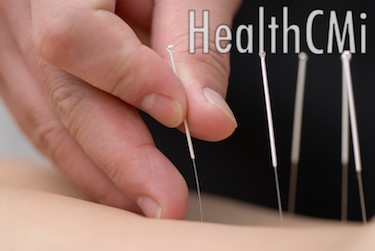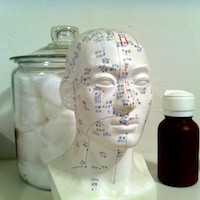Researchers find that acupuncture may help Alzheimer’s disease patients.  The researchers note that their findings suggest that acupuncture improves memory and prevents degradation of brain tissue. They note “that EA (electroacupuncture) may be a promising treatment for AD (Alzheimer’s disease)” and “may improve cognitive function.”
The researchers note that their findings suggest that acupuncture improves memory and prevents degradation of brain tissue. They note “that EA (electroacupuncture) may be a promising treatment for AD (Alzheimer’s disease)” and “may improve cognitive function.”
The findings are a result of a controlled laboratory experiment on cognitively impaired mice with AD. The researchers measured improved cognition, improved brain cell repair and a reduction of brain pathological morphology as a result of electroacupuncture treatments. The results point to a possible treatment modality that may help Alzheimer’s disease patients.
Alzheimer’s disease is a common ailment manifesting in memory loss, dementia and other forms of cognitive impairment. Globally, dementia affects over 24 million individuals and about 70% is due to Alzheimer’s disease. Brain changes in AD patients involve excess “deposition of amyloid plaques, neurofibrillary tangles, and selective neuronal loss in the frontal and temporal cortices, as well as in the hippocampus of the brain.” The research on the effects of acupuncture on AD is hopeful. It was demonstrated that electroacupuncture induces brain cell repair in the affected regions and can prevent the excess buildup of deleterious plaques.
Electroacupuncture reduces brain plaque proliferation associated with Alzheimer’s disease and concomitant dementia. The researchers identified the biochemical actions by which electroacupuncture exerts this therapeutic effect. Electroacupuncture decreases the formation of Aβ-42 deposits. These plaque deposits lead to neuron loss, memory impairment and dementia. Aβ1-42 deposits are cytotoxic and are a biomarker of Alzheimer’s disease. The researchers discovered that electroacupuncture “was a feasible and effective way for lowering Aβ1-42 deposits….” This is important because Aβ antagonists help to restore memory lost due to Aβ deposits in the brain.
Neurogenesis, the creation of neurons, is the process by which neurons are generated from neural stem cells and progenitor cells. Alzheimer’s disease is marked by a significant reduction in brain neurogenesis, especially in the hippocampus. The researchers discovered that repeated electroacupuncture treatments successfully increased neurogenesis in the hippocampus and cortex.
Brain-derived neurotrophic factor (BDNF) assists in the growth and differentiation of new neurons and synapses. It is active in the hippocampus, cortex and other areas of the brain. BDNF is important in the retention of long-term memories and neurogenesis. AD patient’s have decreased levels of BDNF in the brain, especially in the hippocampus. The researchers note, “Our results showed that EA (electroacupuncture) treatment significantly increased the expression of BDNF in both the hippocampus and cortex; this suggests that the increase in BDNF may be involved in the therapeutic effect of EA for AD.” The researchers added, “Our result might suggest that electroacupuncture could induce the protective effect for the central nervous system of aging and Alzheimer’s disease.”
The researchers made some interesting observations, “In the present study, we observed that EA stimulation significantly improved the neurological behavior performance of AD mice, and reduced the deposition of Aβ in the hippocampus and cortex. At the same time, a noticeable increase in neurogenesis and BDNF expression in the hippocampus and cortex was also detected. Thus, our preliminary presumption was that EA stimulation improved neurobehavioral performance through promoting neurogenesis and BDNF expression in the brain.” They added, “In summary, the present study demonstrated that EA stimulation in Baihui (GV 20) acupoint ameliorated learning and memory deficits and reduced Aβ42 deposit in APP/PS1 mice. We propose that the underlying mechanism of EA may be related to the promotion of neurogenesis and the up-regulation of BDNF expression in the hippocampus and cortex.”
AcupunctureProcedure
Electroacupuncture was applied to acupuncture point GV20 (DU20, Baihui) at 1mA at 2-15 Hz for 4 weeks. Treatment was applied over a period of 20 days at 30 minutes per day, 5 days per week. Electroacupuncture was applied with a Hwato brand electroacupuncture device, model SDZ-V, with dense-sparse waves. The point selection and stimulation methods were based on prior experiments demonstrating that GV20 “protects the brain from ischemic injury.”
About HealthCMi
The Healthcare Medicine Institute provides acupuncture CEU continuing education credit for licensed acupuncturists with anytime online courses and live webinars. The HealthCMi news division provides up-to-date research and acupuncture continuing education news.
References:
Li, Xuying, Fan Guo, Qiaomei Zhang, Tingting Huo, Lixin Liu, Haidong Wei, Lize Xiong, and Qiang Wang. "Electroacupuncture decreases cognitive impairment and promotes neurogenesis in the APP/PS1 transgenic mice." BMC complementary and alternative medicine 14, no. 1 (2014): 37.
Wang Q, Peng Y, Chen S, Gou X, Hu B, Du J, Lu Y, Xiong L: Pretreatment with electroacupuncture induces rapid tolerance to focal cerebral ischemia through regulation of endocannabinoid system. Stroke 2009, 40:2157-2164.
Tao J, Xue XH, Chen LD, Yang SL, Jiang M, Gao YL, Wang XB: Electroacupuncture improves neurological deficits and enhances proliferation and differentiation of endogenous nerve stem cells in rats with focal cerebral ischemia. Neurol Res 2010, 32:198-204.
Hwang IK, Chung JY, Yoo DY, Yi SS, Youn HY, Seong JK, Yoon YS: Effects of electroacupuncture at Zusanli and Baihui on brain-derived neurotrophic factor and cyclic AMP response element-binding protein in the hippocampal dentate gyrus. J Vet Med Sci 2010, 72:1431-1436.
Lu Z, Xiong L, Zhu Z, Wang Q, Chen M: Acupoint specificity of electroacupuncture preconditioning effect on cerebral ischemia injury in rats. Chin Acupunct Moxib 2002, 22:671-673.


